 The SLB recently announced the launch of new carbon transparency initiatives to fill key gaps in expertise and data across the wood products value chain, jointly funded with the United States Endowment for Forestry and Communities (the Endowment). The more access the architecture, engineering, and construction (AEC) sector has to carbon accounting data, the better they can understand the full carbon impact of their structures.
The SLB recently announced the launch of new carbon transparency initiatives to fill key gaps in expertise and data across the wood products value chain, jointly funded with the United States Endowment for Forestry and Communities (the Endowment). The more access the architecture, engineering, and construction (AEC) sector has to carbon accounting data, the better they can understand the full carbon impact of their structures.
The SLB will lead, execute, and finance three projects:
- The Wood Supply Shed Carbon Balance Tool involves creating a credible and transparent digital tool to report growth/ drain by wood supply area. This tool could be used to report land carbon value for reporting to the GHG Protocol as well as provide an “A0” add-on (‘A zero’ – a new life cycle stage that would include carbon on land) to the North American Wood Products environmental product declarations (EPDs) in the EC3 database.
- The Fiber Sourcing Transparency Tool will be designed to provide sustainability and forest certification data in a framework that is practical and easily accessed. The tool targets the AEC community, which is interested in sustainability metrics associated with specified wood products and confused about the differences between forest management certification, fiber supply certification, and the sustainability metrics and assurances.
- The A4 Transportation Tool will make the average CO2 equivalent transportation to site metric (A4) available for each region based on data about where products come from and modes of transportation and distances. The tool will be available to life cycle assessment (LCA) databases and WBLCA tools, such as BT/Tally, Athena Impact Estimator, and OneClick. The SLB will provide additional funding to the AWC to execute this project.
In addition to these efforts, the SLB will continue to work with industry partners such as the AWC, the National Alliance of Forest Owners (NAFO), and the Endowment to identify and address other needs in expertise and data across the wood product value chain. Increasing the availability of credible and comprehensive data will position forests and wood products as an attractive vehicle to address carbon mitigation and climate change and expand market share for wood products in the built environment.
The SLB’s investment in this area is in response to the growing need and urgency for this work, including to counter arguments from competitors as they increasingly market their own carbon benefits. Backed by its recent strategic review, the SLB was well- placed to initiate and now lead this important work, and we look forward to sharing results with you over the coming months.
Click here to view the full SLB 2021 Q2 Quarterly Investment Update